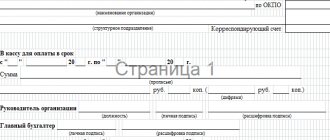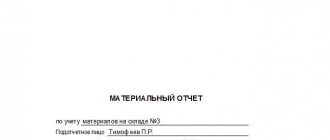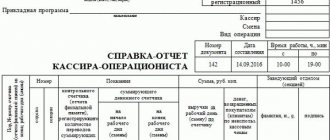The procedure for applying the delivery note to the bag
In accordance with the law, banking institutions are required to accept cash from organizations if they have the following accompanying documents:
- cash receipt order,
- advertisements for cash deposits,
- and a forwarding statement (which, in addition to the statement itself, includes an invoice and a receipt).
The collection bag is filled by the financially responsible employee of the legal entity (cashier or accountant), who also draws up the transmittal sheet. In this case, the bag must be sealed in such a way that the seal cannot be broken without obvious signs of a break-in attempt. The statement is placed inside the collection bag, and the invoice and receipt, which are also included in the accompanying documentation, remain outside.
Filling out the accompanying sheet for the bag: general information
Collection of money in the service sector is carried out by the collection service. Sometimes it is subordinate to a specific bank, and sometimes it is an independent division, but in any case, the procedure for conducting collection and processing documentation is the same. In this case, not only the representative of the service, but also the responsible person at the place where the money is collected must fill out the transmittal sheet. According to the regulations, corrections are not allowed.
A transmittal sheet is a special form that contains information about:
- data and details of the sender;
- the amount collected;
- delivery service;
- persons responsible for transporting valuables.
Also, when registering, be sure to indicate the number of the collection bag. Without it, the form cannot be used, although it is a document of strict accountability.
A cash collection bag is not always used to transport cash. It also transports material assets, documents, etc. In this case, not the amount is indicated, but information about the contents of the bag or the number of the attached document is entered, which contains a list of valuables and is endorsed by the collector.
How to draw up and issue an accompanying sheet for a bag
This document has a unified form under code OKUD 0402300, which is mandatory for use. It includes all the necessary information :
- information about the company and credit institution to which the money is transferred,
- account numbers,
- the transported amount broken down by banknotes,
- source of cash income,
- date of movement.
The statement also contains the original signatures of the responsible persons:
- client,
- accountant
- and a bank cashier who accepts a bag with the exact amount written down in the statement.
It is not necessary to certify a document with the organization’s seal, since since 2020 legal entities are exempt from the obligation to certify their papers with seals and stamps. However, if the use of stamps is registered in the company’s accounting policy, the form must be stamped (one should not forget that some credit institutions, by inertia, require stamps on documents from legal entities, despite the abolition of this requirement in the law).
Transmittal sheet for the bag: sample filling
If you have not previously completed this document, you should have at least a general idea of what it looks like. The best option would be to familiarize yourself with the already completed sample. Below is an example of one of them.
The statement in triplicate is issued only together with the trunk. It should already arrive at the point of sale with information about the collection service.
When transporting money, the sender only needs to enter information and put the necessary signatures. As can be seen from the sample, the document is endorsed by three responsible employees, two of whom are clients, and the third is responsible for collection.
The established filling procedure should be strictly followed, and corrections should not be allowed. The statement is a document of strict accountability, which is why it is extremely difficult to replace a damaged form.
To ensure that the cover sheet is not spoiled, a ready-made sample is offered. With constant cooperation with the same service, only the amount, bag number and names of the responsible persons change in the form. All other information remains standard.
The form is filled out as a carbon copy. The first two sheets, including the handwritten one, are placed in the bag with the money. One of the forms is transferred to the collection service, the second, along with cash or valuables, is sent to the financial institution. The third copy remains with the sender.
How many copies does the statement have?
The statement is written in triplicate (by these we mean the statement itself, the invoice and the receipt):
- the first of which is placed together with the money in the collection suitcase,
- the second is handed over to the employee of the credit institution (it must be endorsed with the collector’s stamp),
- the third remains in the accounting department of the company, which transfers money from the cash desk to the bank.
The last copy must be certified by the collector’s autograph; in the future, this document serves as the basis for entering the necessary information into the company’s cash register.
It should be noted that it is best to fill out the form using special copy paper, in which case all copies will be absolutely identical, not to mention the fact that this will save some time.
Sample of a delivery note for a bag
First it says at the top:
- number of the collection bag to which the statement is attached,
- date of drawing up the document (it must correspond to the date of transfer of money from the company to the banking institution).
Then fill in the “ From ” column. The details of the sender of the money are indicated here (if this is a responsible employee of the enterprise, you should enter his position, last name, first name, patronymic, and if the money is transferred through a collector, then it is enough to enter the full name of the organization whose money is being transported).
In the “ Recipient ” column the addressee of the funds is written (most often the names in the two above lines coincide).
In the line called “ Debit ” the number of the recipient’s bank personal account is entered, in the line “ Credit ” - the number of his current account. Just below the recipient’s TIN and again the account number are indicated.
The following must be included in the document:
- names of the depositing bank and receiving bank of the transported cash,
- indicate their BIC (bank identification code),
- as well as the amount (in words) and the source from which the funds were received.
In the corresponding cells on the right, enter again:
- amount (now in numbers),
- receipt symbol (meaning the code of the source of receipt - if you have any difficulties with this parameter, you can consult a bank specialist),
- breakdown of the amount depending on the source code (if the money was received in different ways).
On the second side of the statement form there is an inventory of the funds being deposited . Sign here:
- number of banknotes, depending on their denomination
- and the sum for each line (calculated by multiplying the value from the first column by the value of the second).
Finally, the statement must be signed by all responsible employees involved in the transportation of funds.
Sample of filling out the accompanying sheet for the bag
How to properly prepare a transmittal sheet:
- The serial number of the document is entered in the line “statement number”.
- The bag number is entered in the field provided.
- In the “from whom” paragraph, information about who represents the organization transferring the funds is indicated (full name)
- The “recipient” line records the name of the organization to which the funds are transferred. If cash is transferred to the bank for the purpose of being credited to the current account of the organization itself, then the same name of the organization should be entered.
- The “debit” line is the recipient’s bank account number
- Line “credit” – beneficiary’s current account number
- The monetary amount is written in numbers. In the “amount in words” column, the monetary amount is recorded in words and must necessarily coincide with the amount written in numbers
- Column “depositing bank” – name and identification code of the bank depositing funds
- Column “recipient bank” – name and identification code of the bank receiving funds
- Item “source of receipt” – indicates the method of receipt and type of funds (funds received from the sale of goods, revenue from retail trade, etc.)
- It is necessary to indicate the TIN and KPP of the organization that receives the cash
- On the reverse side of the document, an inventory of the cash being handed over (denomination, quantity, amount in coins and amount in banknotes) must be entered.
| ★ Best-selling book “Accounting from scratch” for dummies (understand how to do accounting in 72 hours) > 8,000 books purchased |
Filling rules
The legal entity transferring the funds is responsible for preparing the statement. As a rule, this responsibility is assigned to the company cashier.
Paper is necessary to record the integrity of the contents of the bag. The document is drawn up in three blocks: statement, invoice, receipt.
The statement is attached to the bag with cash, the receipt remains with the sending company.
If cash is deposited at the bank without a collector's bag, then an advertisement for cash deposit is issued.
How to fill out form 0402300?
The document is drawn up in three copies:
- for putting in a bag;
- for a bank teller with a collector's stamp;
- for a company that sent cash to a credit institution.
The copy intended for the business entity contains the signature of the collector and is the basis for filling out the cash journal.
A unified procedure has been approved for collection. The statement is filled out according to the unified form OKUD 0402300, its use is mandatory.
Information included in the document on the front side of the form:
- unique serial number of the statement;
- number of the collection bag for moving cash;
- date of drawing up the form (current) and formation of a bag with money;
- the name of the enterprise that owns the funds and transfers them to the bank;
- the name of the recipient of the money to whose address the cash is sent (when credited from the cash register to your own current account, the same legal entity is recorded in the name of the recipient and the sender);
- debit - personal account number in the bank;
- credit - current account of the recipient of monetary assets;
- transferred amount of cash in words and in digital form, kopecks in numbers only;
- depositor bank - a financial company servicing the company transferring funds;
- recipient's bank - a banking institution that accepts cash on behalf of the client for its subsequent crediting to the company's current account;
- details of each financial institution.
The following information about the source of funds is recorded: retail revenue, funds received from the sale of products.
The reverse side of the transmittal sheet is designed as an inventory of cash, broken down by columns:
- denomination of paper bills and coins;
- the quantity of each specified banknote;
- the total result of all funds divided by denomination.
Below the table is a bag opening act, in which the bank employee enters information after opening it.
The statement must contain the original signatures of the responsible specialists: the client, the accounting employee (cashier), the cashier of the credit institution accepting cash.
The receipt serves as proof of the fact that cash was accepted by the collector. When the suitcase with valuables is handed over to the collector, he affixes his autograph and stamp.
The receipt is kept by the company issuing the funds (in accordance with the letter of the Bank of Russia dated October 16, 2015 No. 29-1-1-OE/4065). The invoice is handed over to the collection officer.
It is not necessary to certify the form with the seal of the enterprise; since 2020, enterprises have been legally exempted from the obligation to certify their documentation with seals and stamps.
But if the use of imprints is recorded in the organization’s accounting policies, then the imprint is affixed. Often, despite the abolition of this requirement, banks require a seal on the document.
When filling out the statement, no blots or corrections should be allowed. If inaccuracies are discovered, a new form is drawn up. The statement is stored for 1 year.
Download free form and sample word
cover letter – link.
filling out form 0402300 – excel.
Transmittal sheet for the bag: design features
The statement form is drawn up in three identical copies:
- one is needed to put it inside the bag;
- a second document with a collection stamp is required for a bank teller;
- the third copy must be kept at the enterprise sending cash to the bank.
In an organization, the responsibility for preparing and storing the statement is assigned to the cash worker. On the third form, which the sending company keeps for itself, the collectors put their signature. This document will serve as the basis for filling out the cash register.
Read also: How to find out an apartment by last name and house number
The statement form must be filled out without errors or blots. If inaccuracies or typos are found, the document is drawn up again on a blank form. The procedure for entering information into the document:
- serial numbering of the statement is indicated;
- the number of the bag being sent is indicated;
- in the “from whom” column enter data about the organization that is the owner of the money and transfers these funds to the bank;
- the recipient is the enterprise to which the banknotes are sent (if money is sent to a bank for crediting to its own current account, then the recipient and sender will be the same person);
- An example of filling out a statement involves indicating in the debit the number of the personal bank account assigned to the recipient;
- the loan must include a current account for the recipient of the funds;
- The amount of money is given in words and figures.
The depositor's bank is a financial institution that services the company that deposits the money. The recipient's bank is a financial institution that is instructed by the client to accept money for subsequent crediting to the recipient's account. The relevant fields indicate the details of both banking structures. When entering information about the source of money, you can write:
- the result of the sale of goods;
- revenue generated from retail trade, etc.
On the reverse side, the transmittal sheet contains an inventory of cash:
- denomination of coins and paper banknotes;
- the number of bills or coins for each of the specified denominations;
- the total value of funds broken down by denomination.
The receipt is filled out to form an evidence base confirming the fact that the cash was accepted by the collector. When the bag with valuables is handed over to the collector, he signs the receipt and puts a stamp on the form. The document remains in the custody of the organization issuing the funds (this procedure is prescribed in the Letter of the Bank of Russia dated October 16, 2020 No. 29-1-1-OE/4065).
Once completed, the invoice is handed over along with the bag to the collection officer. The document contains data on the date of cash delivery, the number assigned to the form, information about the transferor and recipient of funds, details of servicing banks, the amount of money, signatures of officials.
Where should I put it?
The statement remains inside the bag, the invoice and receipt, included in a single set, remain outside.
The sequence of filling out the statement for the bag:
- filling of the collector's bag is carried out by the cashier (materially responsible person), he also draws up a transfer sheet, records information about collection and the number of the bag;
- after the arrival of the collectors, who check the compliance of the cash indicated in the statement, the suitcase is sealed so that the seal cannot be broken without clear signs of its unauthorized opening;
- the bag is opened only by authorized persons.
Registration procedure
Filling out the accompanying sheet for the bag is carried out in the following sequence:
- First, enter the collection information and bag number.
- After delivery of the bag and enclosed documentation to the point of sale, the necessary data is entered by the sender.
- After the arrival of the collectors, who are required to check the compliance of the cash with the specified amount, all three copies are endorsed.
- The list is placed in the inner pocket of the bag.
- The bag is sealed and delivered to the financial institution.
- The bag is opened by authorized persons.
Read also: How to find out who owns an apartment
As mentioned above, the form accompanying cash or material assets has a certain form of completion, so often when handing over money by the collection service there is a chance of being refused due to incorrect execution or corrections made. But, if there is an agreement for the provision of collection services, in some cases it is allowed to use a statement with already printed data, in which only the amount is manually entered and signatures are placed.
Important nuances
The form accompanying tangible assets and valuables has special instructions for filling it out; therefore, there is a possibility of receiving a refusal to accept the form and cash due to improper execution or amendments to the document.
Sometimes, if there is a signed agreement for the provision of collection services, it is allowed to use forms with already printed information; it only needs to be supplemented with the amount of funds being transferred and signatures.
Filling out the statement is allowed using a computer, a software package, or manually.
All three parts of the document contain identical information.
In the handwritten version, it is more convenient to record information using carbon paper, which allows you to reduce the time for filling out the form and eliminate triple duplication of data.
The conveyance sheet allows you to clearly identify the funds being transported from the company's cash desk to the credit institution, and ensure their safety and inviolability.
If, when transferring cash to a financial institution from a collector, the data from the statement does not coincide with the funds received by the bank employee, full responsibility rests with the carrier of valuables, that is, with the collection employee.
The article describes typical situations. To solve your problem , write to our consultant or call for free:
+7 (499) 490-27-62 — Moscow — CALL
+7 — St. Petersburg — CALL
+8 ext.849 — Other regions — CALL
Delivery note for the bag
The conveyance sheet for the bag is a document that is used to formalize the delivery of cash to the bank (collection). Three copies of the form are filled out: the first remains in the organization, the second is placed in the collection bag, the third is handed over to the bank employee.
The shelf life of the accompanying sheet for the bag is 1 year.
The copy, which remains with the cashier of the organization with the signature of the collector, serves as the basis for recording the entry in the KM-4 journal - , KM-6 report and KO-4 cash book - download.
Conveyance sheet for the bag. How to prepare without errors
| ★ Best-selling book “Accounting from scratch” for dummies (understand how to do accounting in 72 hours) > 8,000 books purchased |
When collection is carried out, this statement must be prepared in triplicate.
- The first one is to remain in the organization.
- The second one is placed in a bag for collection
- The third one is given to a bank employee
The collector signs one copy and gives it back to the cashier who prepared the collection. From this document, the cashier enters data into a special journal of the cashier-operator (form KM-4) and makes the necessary entries.
When entering data into the statement for the bag, it is very important to ensure that all fields and columns are filled out correctly, since no corrections in the document are allowed. Moreover, mistakes. If you make a mistake, you must enter the data again on a new form.
To avoid mistakes, it is advisable to have a sample before your eyes.
This form can be filled out by hand or entered into the data on a computer. If you fill out the transmittal sheet manually, you can use carbon paper to save time. The statement must contain all correct information about the amount that is transferred to the bank.
There are specific rules for completing this form.
Below are recommendations and a sample form.
Sample of filling out the statement
Instructions for filling out the front side of the form:
Statement for the bag No.: serial unique number of the accompanying sheet.
Bag No.: number of the collection bag for cash.
Date: the current date of registration of the transmittal form and the formation of a bag with cash.
From whom: if cash is handed over by a responsible representative of the organization (for example, cashier, accountant, senior cashier), then his full name is indicated; if cash is handed over through cash collectors, then the full name of the organization handing over the cash is written.
Debit: number of the personal bank account to which cash is credited.
Recipient: name of the company to whose account the money is credited.
Credit: beneficiary's current account number at the servicing bank.
The “debit” and “credit” fields in the statement form can be left blank; the bank specialist will fill them in independently.
TIN: taxpayer identification number of the cash recipient.
Account: number of the recipient's bank account.
Name of depositing bank: name of the bank of the organization depositing cash according to the preliminary statement.
BIC: BIC of the depositing bank.
Receiving Bank Name: The name of the bank of the organization for which the money is intended.
BIC: BIC of the receiving bank.
Amount in words: the amount of cash deposited according to the transmittal sheet is written in words, kopecks are indicated in numbers.
Source of income: type of cash receipt, according to the Instructions of the Bank of Russia.
Filling out the right side of the form:
Amount in numbers: write the amount to be collected in numbers.
Including by symbols: the symbol(s) of the receipt item is filled in according to the nomenclature of symbols and the amount(s) corresponding to the symbol.
Instructions for filling out the back of the form:
On the reverse side of the accompanying sheet for the bag there is an inventory of the cash being handed over.
1 – denomination of a banknote or coin.
2 – the number of banknotes or coins of the specified denomination.
3 – total amount at the specified denomination in figures (the product of indicators 1 and 2 columns).
The invoice form for the bag with cash is filled out in the same way as the transmittal form.
The receipt form for a bag with cash is filled out in the same way.
Form and sample for downloading
accompanying sheet for the bag – link.
accompanying sheet for the bag – link.
Reminder for filling out the accompanying sheet for the bag
Home > Memo
| Document information |
| Date added: |
| Size: |
| Available download formats: |
REMEMBER FOR COMPLETING THE TRANSMISSION SHEET FOR YOUR BAG
For a bag with cash to be handed over to a credit institution, the organization draws up a Transmittal Statement for the bag, consisting of a Statement for the Bag, an Invoice for the Bag and a Receipt for the Bag:
1. In the fields “Statement for bag No.”, “Invoice for bag No.”, “Receipt for bag No.” and “bag No.” the bag number is indicated.
2. In the “Date” field, the date of formation of the bag with cash is indicated.
3. In the “From” field, indicate the last name, first name, patronymic (last, if any) of the depositor of funds - a representative of the legal entity (cashier of the organization that formed the bag). When a bag of cash is handed over by cash collectors, the name of the organization handing over the cash is entered in the “From” field.
4. In the “Debit account No.” field, a twenty-digit personal analytical accounting account is indicated, opened on the corresponding balance sheet accounts for cash accounting.
5. In the “Credit account No.” field:
when depositing funds into subdivisions of a branch of Sberbank of Russia to an account opened in this bank branch, the twenty-digit account number of the organization is indicated;
when depositing funds into divisions of a branch of Sberbank of Russia to an account opened in another branch of Sberbank of Russia/credit organization, the “Credit” field is filled in in accordance with the requirements of regulatory documents governing the provision of this service (the procedure for performing a banking transaction).
Read also: How to make a deed of gift for a house and land and what documents are needed
The entry of balance account numbers in the fields “Debit account No.” and “Credit account No.” is carried out by the bank’s accountant, so mandatory filling out by the organization is not required!
6. In the “Recipient” field, the full (abbreviated) corporate name of the organization to whose account the funds are credited or transferred is indicated.
7. In the fields “TIN”, “KPP”, “OKATO”, “account No.” the corresponding details of the organization receiving the funds are indicated.
8. In the “Name of the depositing bank” field, “OJSC Sberbank of Russia”, the name of the bank branch, the name of the branch and the number of the structural unit (No. 0000/00000) to whose cash desk the funds are deposited are indicated. Clients using the collection service of Sberbank of Russia in Perm indicate in this field the text “OJSC Sberbank of Russia, West Ural Bank.”
9. In the “BIC” field, the BIC of the depositing bank is indicated.
10. In the “Name of the recipient bank” field, indicate “OJSC Sberbank of Russia”, the name of the bank branch, the name of the branch and the number of the structural unit (No. 0000/00000) in which the Recipient’s bank account is opened.
11. In the “BIC” field, the BIC of the recipient bank is indicated.
12. In the fields “Amount in words” and “Amount in figures” indicate the amount in words and the amount in figures, respectively.
The field “including by symbols: amount, symbol” indicates the symbols used when preparing the Cash Turnover Report in accordance with Bank of Russia Directive No. 1376-U dated January 16, 2004.
Amounts attributed to one symbol of the specified Report must be shown in the corresponding positions of the above-mentioned field in one line (total amount: without breaking down into parts, i.e. the symbol number and the corresponding amount attributed to this symbol).
Individual entrepreneurs, regardless of the source of contribution, use cash symbol 19.
14. In the field “Source of receipt” the source of receipt of cash is indicated in accordance with Directive of the Bank of Russia dated January 16, 2004 N 1376-U. The source of the contribution must match the cash symbol.
15. In the field “Customer’s signature” – the signature of the depositor of funds is affixed - a representative of the legal entity (cashier of the organization who formed the bag).
The conveyance sheet, the delivery note for the bag, as well as the receipt for the bag are filled out by the organization indicating all the necessary details.
Corrections in the transmittal sheet are not allowed.
The information in the delivery note for bag 0402300, the invoice for bag 0402300 and the receipt for bag 0402300 must be identical.
Compliance with the above requirements on the part of organizations is a mandatory condition for the provision of cash acceptance services
How to properly prepare a document
In this case, the unified form 0402300 is used. Corrections in it are unacceptable, so if there are any erasures, you will have to rewrite it again. The paper consists of three parts, which are filled out at the time of collection:
- The statement itself is placed in the collection bag along with the cash.
- The invoice is handed over to the cashier who accepts the cash. The form must be signed and stamped by the collector.
- The receipt remains in the accounting department of the organization. This part is also certified by the collection officer.
The question arises: how to fill out the three sections, what is the difference between them. All parts of the statement contain similar information. It is more convenient to enter information using carbon paper. This will avoid rewriting the same data three times.
Filling example
Both handwritten and electronic forms are acceptable. The filling sample shows the sequence of entering information:
- At the beginning of the form, the number of the collection bag and the date of its formation are written down.
- After this, the data of the sender of the cash is entered, that is, the name of the organization donating the funds. The “From” column is intended for this purpose.
- The “Recipient” line indicates the recipient of the transferred amount. Most often, this is the renting enterprise itself, that is, the information in this and the previous column coincides.
- In the “Debit” block, enter the recipient’s bank account number, “Credit” - the company’s current account number.
- The name of the bank indicating its BIC.
- The amount in words and the name of the source of its receipt. The amount in digital format is indicated right next to it, and the source is entered using a code. If you have difficulty writing the code, you can contact the cashier for help. The most commonly used code is 02 – trade or retail revenue.
If the money was received in different ways, for example, partly from proceeds (02), and partly as payment for a loan (14), then the amount is broken down according to the sources of transfers.
The form is also provided with a reverse side on which information is displayed in tabular format. The table columns are as follows:
- Denomination of banknotes or coins.
- The number of banknotes or coins of each denomination.
- The amount in numbers for each denomination, which is obtained by multiplying the two previous columns.
Below the table is the bag opening act, which is filled out by the bank cashier after opening the bag. Finally, the statement is signed by all persons involved in packaging and transportation.
Accompanying statement
Appendix No. 8 to the Rules for the carriage of goods by road
Form
ACCOMPANYING SHEET Accompanying Sheet N Copy N ¦ ¦ 1. Consignor ¦ 2. Consignee ¦ _____________________________________¦____________________________________ _____________________________________¦___________________________________ (last name, first name, patronymic, address of place¦ (last name, first name, patronymic, residence address, data on means of communication¦ of place residence, data on - for an individual, ¦ means of communication - for an individual, _____________________________________¦____________________________________ _____________________________________¦___________________________ full name, address of place ¦ full name, address of location - for a legal entity) ¦ location - for a legal entity) _____________________________________¦ _____________________________________ _____________________________________¦____________________________________ (last name, first name, patronymic, data on the ¦ (last name, first name, patronymic, data on the means of communication of the person responsible for the transportation) ¦ responsible for the transportation) 3. Name of the cargo __________________________________________________________________________ __________________________________________________________________________ (shipping name cargo (for dangerous goods - in accordance with ADR), its condition and other necessary information about the cargo) __________________________________________________________________________ __________________________________________________________________________ (number of packages, markings) __________________________________________________________________________ __________________________________________________________________________ (net (gross) weight of packages in kilograms, dimensions (height, width and length ) in meters, volume of packages in cubic meters) _________________________________________________________________________ _________________________________________________________________________ (in case of transportation of dangerous goods - information on each dangerous substance, material or product in accordance with paragraph 5.4.1 of ADR) 4. Container ————————— ———————————————— Number, ¦Date and time ¦ Date and time ¦ Date and time ¦ Delivery date ¦ return, ¦ delivery ¦ and time of return, capacity ¦ for loading ¦ loading period ¦ for unloading ¦ unloading period ————+————-+—————+—————+—————— 5. Instructions of the shipper __________________________________________________________________________ __________________________________________________________________________ (instructions necessary for fulfillment phytosanitary, sanitary, quarantine, customs and other requirements established by the legislation of the Russian Federation) __________________________________________________________________________ __________________________________________________________________________ (recommendations on deadlines and temperature conditions for transportation, information on locking and sealing devices (if provided by the shipper)) 6. Delivery (reception) of the container ¦ 7. Delivery (reception) of the container ¦ _____________________________________¦____________________________________ (address of the loading place) ¦ (address of the unloading place) _____________________________________¦____________________________________ _____________________________________¦__________________________________________ (date and time of delivery of the transport ¦ (date and time of submission of the vehicle for loading) ¦ means for unloading) _____________________________________¦__________________________________________ _____________________________________¦____________________________________ (actual date and time ¦ (actual date and time of arrival (departure)) ¦ arrival (departure)) _____________________________________¦__________________________________________ _____________________________________¦____________________________________ (actual condition of the container ¦ (actual condition of the container and its sealing) ¦ and its sealing) _____________________________________¦____________________________________ _____________________________________¦____________________________________ (cargo weight, number of cargo ¦ (cargo weight, number of cargo items) ¦ places) _____________________________________¦____________________________________ _____________________________________¦____________________________________ (signature and seal imprint ¦ (signature and seal imprint of the shipper (if any), ¦ consignee (if any), signature of the driver who accepted ¦ signature of the driver who handed over the container) ¦ container) 8. Carrier _____________________________________¦____________________________________ _____________________________________¦____________________________________ (last name, first name, patronymic, address of place¦ (last name, first name, patronymic, residence data - for an individual) ¦ means of communication (if any) ¦ driver (drivers)) _____________________________________¦____________________________________ _____________________________________¦____________________________________ (name and address of the place ¦ (information about the waybill(s)) of location - for a legal entity) ¦ _____________________________________¦____________________________________ _____________________________________ ¦__________________________________________ (last name, first name, patronymic of the person ¦ responsible for transportation, ¦ data on means of communication) ¦ 9. Vehicle ___________________________________________¦______________________________ ___________________________________________¦______________________________ (type, brand, load capacity in tons) ¦ (registration number) 10. Date of compilation signed )








